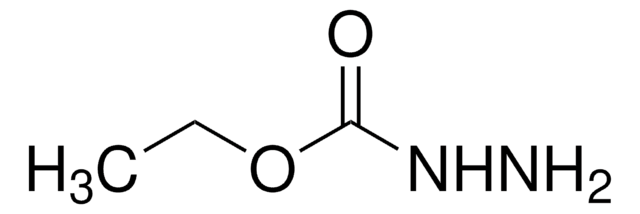42077
Cianoborohidruro de sodio
Fabricación farmacéutica
Sinónimos:
Cianotrihidroborato de sodio
About This Item
Productos recomendados
origen biológico
synthetic
Nivel de calidad
Ensayo
≥97% (wt., redox titration)
Formulario
powder
caducidad
limited shelf life, expiry date on the label
idoneidad de la reacción
reagent type: reductant
impurezas
≤1000 ppm residual solvent (tetrahydrofuran)
≤3000 ppm residual solvent (toluene)
mp
>242 °C (dec.) (lit.)
solubilidad
H2O: 100 mg/mL, clear to faintly turbid, colorless
trazas de anión
(may contain traces of cyanide and borohydride)
trazas de catión
Ag: ≤2.5 mg/kg
Cd: ≤2.5 mg/kg
Cr: ≤2.5 mg/kg
Cu: ≤10 mg/kg
Fe: ≤10 mg/kg
Mo: ≤2.5 mg/L
Ni: ≤2.5 mg/kg
idoneidad
suitable for manufacturing use
cadena SMILES
[Na+].[BH3-]C#N
InChI
1S/CH3BN.Na/c2-1-3;/h2H3;/q-1;+1
Clave InChI
CVDUGUOQTVTBJH-UHFFFAOYSA-N
¿Está buscando productos similares? Visita Guía de comparación de productos
Palabra de señalización
Danger
Frases de peligro
Clasificaciones de peligro
Acute Tox. 2 Dermal - Acute Tox. 2 Inhalation - Acute Tox. 2 Oral - Aquatic Acute 1 - Aquatic Chronic 1 - Eye Dam. 1 - Flam. Sol. 1 - Skin Corr. 1B - Water-react 1
Riesgos supl.
Código de clase de almacenamiento
4.3 - Hazardous materials which set free flammable gases upon contact with water
Clase de riesgo para el agua (WGK)
WGK 3
Punto de inflamabilidad (°F)
158.0 °F - closed cup
Punto de inflamabilidad (°C)
70 °C - closed cup
Elija entre una de las versiones más recientes:
¿Ya tiene este producto?
Encuentre la documentación para los productos que ha comprado recientemente en la Biblioteca de documentos.
Los clientes también vieron
Active Filters
Nuestro equipo de científicos tiene experiencia en todas las áreas de investigación: Ciencias de la vida, Ciencia de los materiales, Síntesis química, Cromatografía, Analítica y muchas otras.
Póngase en contacto con el Servicio técnico















